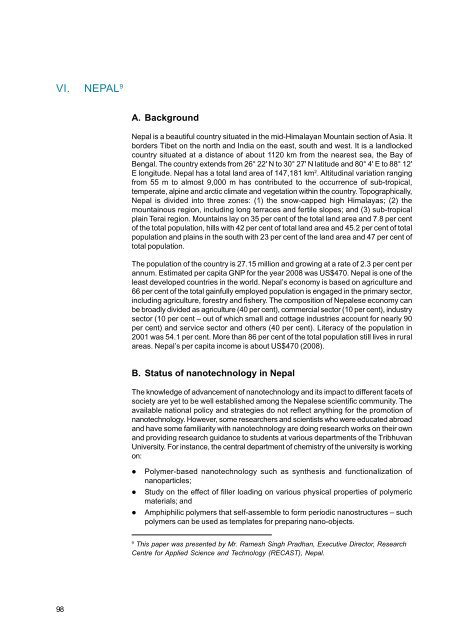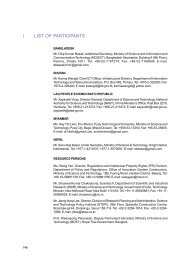innovation in nanotechnology an asia-pacific perspective - apctt
innovation in nanotechnology an asia-pacific perspective - apctt
innovation in nanotechnology an asia-pacific perspective - apctt
You also want an ePaper? Increase the reach of your titles
YUMPU automatically turns print PDFs into web optimized ePapers that Google loves.
VI. NEPAL 9<br />
98<br />
A. Background<br />
Nepal is a beautiful country situated <strong>in</strong> the mid-Himalay<strong>an</strong> Mounta<strong>in</strong> section of Asia. It<br />
borders Tibet on the north <strong>an</strong>d India on the east, south <strong>an</strong>d west. It is a l<strong>an</strong>dlocked<br />
country situated at a dist<strong>an</strong>ce of about 1120 km from the nearest sea, the Bay of<br />
Bengal. The country extends from 26° 22' N to 30° 27' N latitude <strong>an</strong>d 80° 4' E to 88° 12'<br />
E longitude. Nepal has a total l<strong>an</strong>d area of 147,181 km 2 . Altitud<strong>in</strong>al variation r<strong>an</strong>g<strong>in</strong>g<br />
from 55 m to almost 9,000 m has contributed to the occurrence of sub-tropical,<br />
temperate, alp<strong>in</strong>e <strong>an</strong>d arctic climate <strong>an</strong>d vegetation with<strong>in</strong> the country. Topographically,<br />
Nepal is divided <strong>in</strong>to three zones: (1) the snow-capped high Himalayas; (2) the<br />
mounta<strong>in</strong>ous region, <strong>in</strong>clud<strong>in</strong>g long terraces <strong>an</strong>d fertile slopes; <strong>an</strong>d (3) sub-tropical<br />
pla<strong>in</strong> Terai region. Mounta<strong>in</strong>s lay on 35 per cent of the total l<strong>an</strong>d area <strong>an</strong>d 7.8 per cent<br />
of the total population, hills with 42 per cent of total l<strong>an</strong>d area <strong>an</strong>d 45.2 per cent of total<br />
population <strong>an</strong>d pla<strong>in</strong>s <strong>in</strong> the south with 23 per cent of the l<strong>an</strong>d area <strong>an</strong>d 47 per cent of<br />
total population.<br />
The population of the country is 27.15 million <strong>an</strong>d grow<strong>in</strong>g at a rate of 2.3 per cent per<br />
<strong>an</strong>num. Estimated per capita GNP for the year 2008 was US$470. Nepal is one of the<br />
least developed countries <strong>in</strong> the world. Nepal’s economy is based on agriculture <strong>an</strong>d<br />
66 per cent of the total ga<strong>in</strong>fully employed population is engaged <strong>in</strong> the primary sector,<br />
<strong>in</strong>clud<strong>in</strong>g agriculture, forestry <strong>an</strong>d fishery. The composition of Nepalese economy c<strong>an</strong><br />
be broadly divided as agriculture (40 per cent), commercial sector (10 per cent), <strong>in</strong>dustry<br />
sector (10 per cent – out of which small <strong>an</strong>d cottage <strong>in</strong>dustries account for nearly 90<br />
per cent) <strong>an</strong>d service sector <strong>an</strong>d others (40 per cent). Literacy of the population <strong>in</strong><br />
2001 was 54.1 per cent. More th<strong>an</strong> 86 per cent of the total population still lives <strong>in</strong> rural<br />
areas. Nepal’s per capita <strong>in</strong>come is about US$470 (2008).<br />
B. Status of <strong>n<strong>an</strong>otechnology</strong> <strong>in</strong> Nepal<br />
The knowledge of adv<strong>an</strong>cement of <strong>n<strong>an</strong>otechnology</strong> <strong>an</strong>d its impact to different facets of<br />
society are yet to be well established among the Nepalese scientific community. The<br />
available national policy <strong>an</strong>d strategies do not reflect <strong>an</strong>yth<strong>in</strong>g for the promotion of<br />
<strong>n<strong>an</strong>otechnology</strong>. However, some researchers <strong>an</strong>d scientists who were educated abroad<br />
<strong>an</strong>d have some familiarity with <strong>n<strong>an</strong>otechnology</strong> are do<strong>in</strong>g research works on their own<br />
<strong>an</strong>d provid<strong>in</strong>g research guid<strong>an</strong>ce to students at various departments of the Tribhuv<strong>an</strong><br />
University. For <strong>in</strong>st<strong>an</strong>ce, the central department of chemistry of the university is work<strong>in</strong>g<br />
on:<br />
� Polymer-based <strong>n<strong>an</strong>otechnology</strong> such as synthesis <strong>an</strong>d functionalization of<br />
n<strong>an</strong>oparticles;<br />
� Study on the effect of filler load<strong>in</strong>g on various physical properties of polymeric<br />
materials; <strong>an</strong>d<br />
� Amphiphilic polymers that self-assemble to form periodic n<strong>an</strong>ostructures – such<br />
polymers c<strong>an</strong> be used as templates for prepar<strong>in</strong>g n<strong>an</strong>o-objects.<br />
9 This paper was presented by Mr. Ramesh S<strong>in</strong>gh Pradh<strong>an</strong>, Executive Director, Research<br />
Centre for Applied Science <strong>an</strong>d Technology (RECAST), Nepal.



